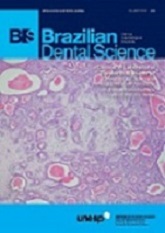Microtensile bond strength to Er:YAG laser pretreated dentin
DOI:
https://doi.org/10.14295/bds.2014.v17i1.954Resumo
Objective: Although the effects of Er:YAG (erbium:yttrium aluminium garnet) laser on cavity preparation as well as on dentin bonding to composite have been described in the literature, the longevity of this bond is still unknown. So, this study evaluated the short-term microtensile bond strength to dentin samples after different protocols of surface treatment. Materials and Methods: 60 bovine incisors were cleaned, worn to expose a dentin area and subdivided into groups according to treatment conditions: surface treatment (no irradiation – control group; dentin irradiation with Er:YAG laser 250 mJ/4 Hz; 160 mJ/10 Hz), adhesive system (Clearfil SE Bond - Kuraray; Adper Single Bond 2 - 3M/ESPE), and storage time (24 h; 90 days). After adhesive procedures, a block of Z250 composite resin (3M/ESPE) was built-up on each tooth. The teeth were sectioned to obtain samples for the microtensile bond strength test. Half of the samples were tested 24 h after cutting, and the other half were stored in distilled water for 90 days before testing. Intergroup analysis was also performed considering the same variables using ANOVA for multiple comparisons with Tukey test with a significance level of 5%. Data showed weaker bond strength for groups previously treated with laser (p < 0.05) compared with control groups, and these were not influenced by adhesive system used, nor by storage period. Stereoscopic microscope observations showed that fractures occurred predominantly at the adhesive interface in the groups irradiated with the Er:YAG laser. Conclusion: Within the parameters and variables used in this study, the Er:YAG laser could not provide an additional improvement in dentin-resin bond strength, irrespective of the type of adhesive system used or the storage period evaluated.
KEYWORDS
Adhesive systems; Er:YAG laser; Microtensile bond
strength.
Downloads
Downloads
Publicado
Como Citar
Edição
Seção
Licença
TRANSFERÊNCIA DE DIREITOS AUTORAIS E DECLARAÇÃO DE RESPONSABILIDADE
Toda a propriedade de direitos autorais do artigo "____________________________________________________________________" é transferido do autor(es) para a CIÊNCIA ODONTOLÓGICA BRASILEIRA, no caso do trabalho ser publicado. O artigo não foi publicado em outro lugar e não foi submetido simultaneamente para publicação em outra revista.
Vimos por meio deste, atestar que trabalho é original e não apresenta dados manipulados, fraude ou plágio. Fizemos contribuição científica significativa para o estudo e estamos cientes dos dados apresentados e de acordo com a versão final do artigo. Assumimos total responsabilidade pelos aspectos éticos do estudo.
Este texto deve ser impresso e assinado por todos os autores. A versão digitalizada deverá ser apresentada como arquivo suplementar durante o processo de submissão.




























